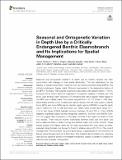Files in this item
Seasonal and ontogenetic variation in depth use by a critically endangered benthic elasmobranch and its implications for spatial management
Item metadata
| dc.contributor.author | Thorburn, James A. | |
| dc.contributor.author | Wright, Peter | |
| dc.contributor.author | Lavender, Edward | |
| dc.contributor.author | Dodd, Jane | |
| dc.contributor.author | Neat, Francis | |
| dc.contributor.author | Martin, Julien | |
| dc.contributor.author | Lynam, Caroline | |
| dc.contributor.author | James, Mark Andrew | |
| dc.date.accessioned | 2021-07-26T10:30:03Z | |
| dc.date.available | 2021-07-26T10:30:03Z | |
| dc.date.issued | 2021-07-19 | |
| dc.identifier | 274711504 | |
| dc.identifier | 7fae1145-5188-4e1f-9ca1-79a5ad485063 | |
| dc.identifier | 85111911860 | |
| dc.identifier | 000678174900001 | |
| dc.identifier.citation | Thorburn , J A , Wright , P , Lavender , E , Dodd , J , Neat , F , Martin , J , Lynam , C & James , M A 2021 , ' Seasonal and ontogenetic variation in depth use by a critically endangered benthic elasmobranch and its implications for spatial management ' , Frontiers in Marine Science , vol. 8 , 656368 . https://doi.org/10.3389/fmars.2021.656368 | en |
| dc.identifier.issn | 2296-7745 | |
| dc.identifier.other | ORCID: /0000-0002-7182-1725/work/97473530 | |
| dc.identifier.other | ORCID: /0000-0002-8040-7489/work/97473882 | |
| dc.identifier.uri | https://hdl.handle.net/10023/23623 | |
| dc.description | The project was undertaken through the Movement Ecology of the Flapper skate project at St Andrews and received support from the Ecology and Conservation Group, Marine Scotland Science, and Marine Scotland Planning & Policy and NatureScot. It was funded by Marine Scotland projects SP004 and SP02B0 and NatureScot project 015960. | en |
| dc.description.abstract | Seasonal and ontogenetic variation in depth use by benthic species are often concomitant with changes in their spatial distribution. This has implications for the efficacy of spatial conservation measures such as Marine Protected Areas (MPAs). The critically endangered flapper skate (Dipturus intermedius) is the designation feature of an MPA in Scotland. This species is generally associated with deeper waters >100 m; however, little is known about its seasonal or ontogenetic variation in habitat use. This study used archival depth data from 25 immature and mature flapper skate tagged in the MPA over multiple years. Time series ranged from 3 to 772 (mean = 246) days. Generalised additive mixed models and highest density intervals were used to identify home (95%) and core (50%) highest density depth regions (HDDRs) to quantify depth use in relation to time of year and body size. Skate used a total depth range of 1 – 312 m, but home HDDRs typically occurred between 20 – 225 m. Core HDDRs displayed significant seasonal and ontogenetic variation. Summer core HDDRs (100 – 150 m) suggest high occupancy of the deep trenches in the region by skate of most size classes. There was an inverse relationship between body size and depth use, and a seasonal trend of skate moving into shallow water over winter months. These results suggest flapper skate are not solely associated with deep water, as skate, especially large females, are frequently found in shallow waters (25 – 75 m). The current management, which protects the entire depth range, is appropriate for the protection of flapper skate through much of its life-history. This research demonstrates why collecting data across seasonal scales and multiple ontogenetic stages is needed to assess the effectiveness of spatial management. | |
| dc.format.extent | 15 | |
| dc.format.extent | 10232336 | |
| dc.language.iso | eng | |
| dc.relation.ispartof | Frontiers in Marine Science | en |
| dc.subject | Dipturus intermedius | en |
| dc.subject | Flapper skate | en |
| dc.subject | Highest density intervals | en |
| dc.subject | Home and core depth range | en |
| dc.subject | Marine protected area | en |
| dc.subject | Rajidae | en |
| dc.subject | Spatial ecology | en |
| dc.subject | GC Oceanography | en |
| dc.subject | QH301 Biology | en |
| dc.subject | NDAS | en |
| dc.subject | SDG 14 - Life Below Water | en |
| dc.subject.lcc | GC | en |
| dc.subject.lcc | QH301 | en |
| dc.title | Seasonal and ontogenetic variation in depth use by a critically endangered benthic elasmobranch and its implications for spatial management | en |
| dc.type | Journal article | en |
| dc.contributor.institution | University of St Andrews. Coastal Resources Management Group | en |
| dc.contributor.institution | University of St Andrews. School of Biology | en |
| dc.contributor.institution | University of St Andrews. Marine Alliance for Science & Technology Scotland | en |
| dc.identifier.doi | 10.3389/fmars.2021.656368 | |
| dc.description.status | Peer reviewed | en |
This item appears in the following Collection(s)
Items in the St Andrews Research Repository are protected by copyright, with all rights reserved, unless otherwise indicated.

